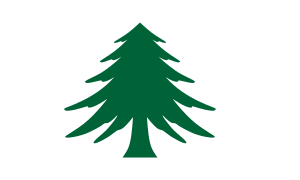Thompson's War facts for kids
Thompson's War was a small fight that happened early in the American Revolutionary War. It was a clash between a group of American fighters, called Patriots, led by Samuel Thompson, and people who supported the British, known as Loyalists. The British warship HMS Canceaux also helped the Loyalists. This confrontation didn't cause any deaths, but it led to the Burning of Falmouth five months later, where the British burned down the town. Falmouth is now known as Portland, Maine, but back then, Maine was part of Massachusetts.
How the Fight Started
Samuel Thompson, who owned a tavern in Brunswick, Maine, was an important local leader. He was elected to the town's government several times and became the commander of the Brunswick local army, called the militia, in 1774. He also led the local group that made sure people followed the rules of the Continental Association. This association was created by the First Continental Congress to boycott, or stop buying, all goods from Great Britain.
On March 2, 1775, the Continental Association tried to stop a ship from delivering supplies like sails and ropes to Captain Samuel Coulson, a Loyalist shipbuilder in Portland. Coulson asked for more time because his ship needed repairs after its long trip across the Atlantic Ocean.
While the repairs were happening, the British warship HMS Canceaux was sent from Boston to protect Coulson. It arrived on March 29, and Coulson began unloading his British goods with the warship's protection.
The famous battles of Lexington and Concord happened about 90 miles (150 km) south of where Canceaux was anchored. When news of these battles reached Brunswick on April 21, the Brunswick militia decided to try and capture the British warship.
Militia Takes Action
Fifty militiamen from Brunswick secretly traveled to Portland in small boats. As a kind of uniform, they wore a small branch of spruce in their hats. They also carried a larger spruce tree with its lower branches removed as their battle flag.
The crew of Canceaux was ready to stop any small boats from getting close to their ship. However, on May 9, 1775, Thompson's militia managed to capture the warship's captain, Lieutenant Henry Mowat. He was on shore at the time, arranging church services for his crew.
The first officer on Canceaux fired two cannon salutes towards Portland. These were just loud noises (gunpowder without cannonballs) to warn the town. He threatened to shell Portland if Captain Mowat was not released. About 600 militiamen from nearby towns quickly gathered. People in Portland then started talking with the British to prevent their town from being attacked.
In the end, Mowat was allowed to go back to his ship. But when he demanded that Thompson be arrested, the Americans refused. The large group of militiamen then forced Canceaux to leave the port on May 15.
What Happened Next
The militiamen were disappointed they couldn't capture the warship. They showed their frustration by looting the homes of Coulson and another Loyalist, Sheriff Tyng, before going back to their own towns.
News of Thompson's brave attempt encouraged other militiamen. A month later, fighters in Machias, Maine, captured the British armed schooner Margaretta in the battle of Machias.
Lieutenant Mowat brought Canceaux back to Portland in October. This time, he set fires that left many people in Portland without homes as winter was coming.
The Massachusetts House of Representatives recognized Samuel Thompson for his leadership after the battles of Lexington and Concord. They promoted him to Brigadier of the Cumberland County, Maine militia on February 8, 1776. The spruce trees his men carried also inspired the design of the Pine Tree Flag, which became the Massachusetts naval ensign (naval flag) in April 1776.
Thompson continued to be involved in public service. He was regularly elected to the Massachusetts General Court (the state's legislature) until he passed away in 1798 at 63 years old.
See also
 In Spanish: Guerra de Thompson para niños
In Spanish: Guerra de Thompson para niños


